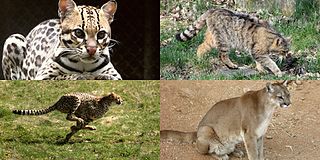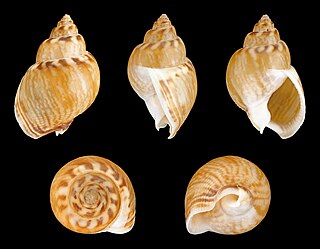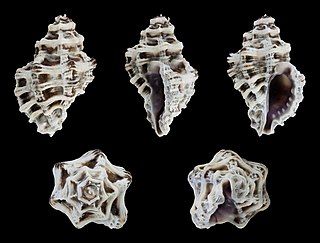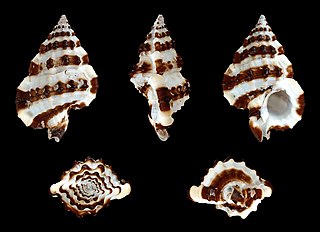
Order is one of the eight major hierarchical taxonomic ranks in Linnaean taxonomy. It is classified between family and class. In biological classification, the order is a taxonomic rank used in the classification of organisms and recognized by the nomenclature codes. An immediately higher rank, superorder, is sometimes added directly above order, with suborder directly beneath order. An order can also be defined as a group of related families.

The skimmers, forming the genus Rynchops, are tern-like birds in the family Laridae. The genus comprises three species found in South Asia, Africa, and the Americas. They were formerly known as the scissorbills.

Sterna is a genus of terns in the bird family Laridae. The genus used to encompass most "white" terns indiscriminately, but mtDNA sequence comparisons have recently determined that this arrangement is paraphyletic. It is now restricted to the typical medium-sized white terns occurring near-globally in coastal regions.

The clapper rail is a member of the rail family, Rallidae. The taxonomy for this species is confusing and still being determined. It is a large brown rail that is resident in wetlands along the Atlantic coasts of the eastern United States, eastern Mexico and some Caribbean islands. This species was formerly considered to be conspecific with the mangrove rail.

The red-knobbed coot or crested coot,, is a member of the rail and crake bird family, the Rallidae.

Systema Naturae is one of the major works of the Swedish botanist, zoologist and physician Carl Linnaeus (1707–1778) and introduced the Linnaean taxonomy. Although the system, now known as binomial nomenclature, was partially developed by the Bauhin brothers, Gaspard and Johann, Linnaeus was first to use it consistently throughout his book. The first edition was published in 1735. The full title of the 10th edition (1758), which was the most important one, was Systema naturæ per regna tria naturæ, secundum classes, ordines, genera, species, cum characteribus, differentiis, synonymis, locis, which appeared in English in 1806 with the title: "A General System of Nature, Through the Three Grand Kingdoms of Animals, Vegetables, and Minerals, Systematically Divided Into their Several Classes, Orders, Genera, Species, and Varieties, with their Habitations, Manners, Economy, Structure and Pecularities".

Crax is a genus of curassows in the order Galliformes, a clade of large, heavy-bodied, ground-feeding birds. They are known from tropical South America with one species, the great curassow, ranging northwards through Central America as far as Mexico. The curassows in this genus are noted for their sexual dimorphism; males are more boldly coloured than females and have facial ornamentation such as knobs and wattles. They are also characterised by curly crests and contrastingly-coloured crissa. Crax curassows probably originated as a distinct lineage during the Late Miocene. During the Messinian, the ancestral Crax split into two lineages separated by the Colombian Andes and the Cordillera de Mérida which uplifted at that time. The northern lineage radiated into the great, blue-billed, and yellow-knobbed curassows, while the four southern species evolved as they became separated by the uplifting of various mountain ranges.

Felinae is a subfamily of the Felidae and comprises the small cats having a bony hyoid, because of which they are able to purr but not roar. Other authors have proposed an alternative definition for this subfamily, as comprising only the living conical-toothed cat genera with two tribes, the Felini and Pantherini, and excluding the extinct sabre-toothed Machairodontinae.

The scaled pigeon is a large New World tropical dove. It is a resident breeder from southern Mexico south to western Ecuador, southern Brazil, northern Argentina, and Trinidad.

The great albatrosses are seabirds in the genus Diomedea in the albatross family. The genus Diomedea formerly included all albatrosses except the sooty albatrosses, but in 1996 the genus was split, with the mollymawks and the North Pacific albatrosses both being elevated to separate genera.

Strix is a genus of owls in the typical owl family (Strigidae), one of the two generally accepted living families of owls, with the other being the barn-owl (Tytonidae). Common names are earless owls or wood owls, though they are not the only owls without ear tufts, and "wood owl" is also used as a more generic name for forest-dwelling owls. Neotropical birds in the genus Ciccaba are sometimes included in Strix.

The Hispaniolan euphonia is a bird species in the finch family, Fringillidae that is endemic to the island of Hispaniola in the Caribbean.

Lepidopterology is a branch of entomology concerning the scientific study of moths and the two superfamilies of butterflies. Someone who studies in this field is a lepidopterist or, archaically, an aurelian.

Western Atlantic seabream is an ocean-going species of fish in the family, Sparidae. It was first described in 1758 by the "father of modern taxonomy," Carl Linnaeus, in the 10th edition of his book, Systema Naturae. Within their native range, Western Atlantic seabream are also known as the seabream, brim, tropical sheepshead, chopa amarilla, or salema. Although they are eaten, and have been described as pan fish, Western Atlantic seabream have not gained the popularity as a gamefish that their relative, the sheepshead has.

Tritia mutabilis, common name : the mutable nassa, is a species of sea snail, a marine gastropod mollusk in the family Nassariidae, the nassa mud snails or dog whelks.

Murichorda fiscellum, common name : the little basket drupe, is a species of sea snail, a marine gastropod mollusk in the family Muricidae, the murex snails or rock snails.

Gyrineum gyrinum is a species of predatory sea snail, a marine gastropod mollusk in the family Cymatiidae.

The 12th edition of Systema Naturae was the last edition of Systema Naturae to be overseen by its author, Carl Linnaeus. It was published by Laurentius Salvius in Holmia (Stockholm) in three volumes, with parts appearing from 1766 to 1768. It contains many species not covered in the previous edition, the 10th edition which was the starting point for zoological nomenclature.

Episcomitra cornicula is a species of sea snail, a marine gastropod mollusk, in the family Mitridae, the miters or miter snails.

Thiara amarula is a species of gastropod belonging to the family Thiaridae.




















